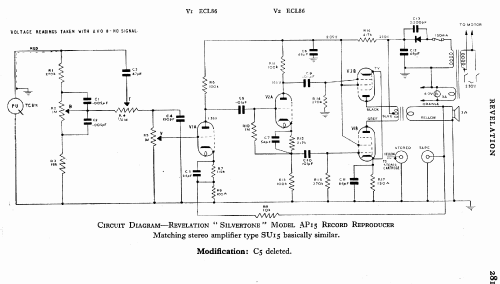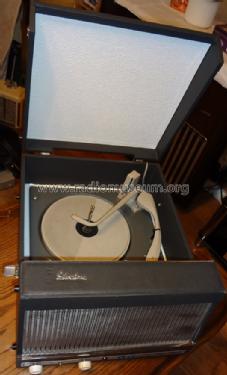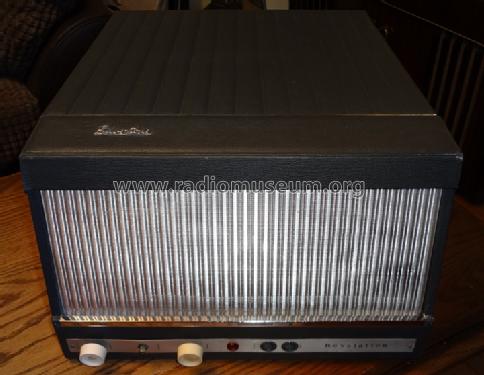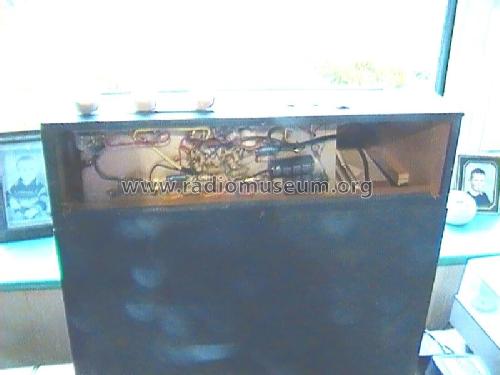Silvertone AP15
Revelation; (Where?)
- Land
- Grossbritannien (UK)
- Hersteller / Marke
- Revelation; (Where?)
- Jahr
- 1963 ?
- Kategorie
- Ton-/Bildspeichergerät oder -Spieler
- Radiomuseum.org ID
- 169569
Klicken Sie auf den Schaltplanausschnitt, um diesen kostenlos als Dokument anzufordern.
- Anzahl Röhren
- 2
- Hauptprinzip
- NF-Verstärkung
- Wellenbereiche
- - ohne
- Spezialitäten
- Plattenspieler+NFV+LS
- Betriebsart / Volt
- Wechselstromspeisung / 240 Volt
- Lautsprecher
- Dynamischer LS, keine Erregerspule (permanentdynamisch)
- Belastbarkeit / Leistung
- 6 W (Qualität unbekannt)
- von Radiomuseum.org
- Modell: Silvertone AP15 - Revelation; Where?
- Bemerkung
- Record reproducer fitted with BSR Monarch 4 speed autochanger type UA16. Can operate in stereo if connected to additional amplifier SU15.
- Datenherkunft
- -- Schematic
- Literatur/Schema (1)
- Radio And Television Servicing books (R&TVS)
- Autor
- Modellseite von Keith Staines angelegt. Siehe bei "Änderungsvorschlag" für weitere Mitarbeit.
- Weitere Modelle
-
Hier finden Sie 6 Modelle, davon 2 mit Bildern und 5 mit Schaltbildern.
Alle gelisteten Radios usw. von Revelation; (Where?)
Sammlungen
Das Modell Silvertone befindet sich in den Sammlungen folgender Mitglieder.
Forumsbeiträge zum Modell: Revelation; Where?: Silvertone AP15
Threads: 1 | Posts: 1
I have owned a Silvertone AP15 record player for maybe 20 years (purchased second hand at a fleamarket/carboot sale). To the best of my knowledge the model dates from about 1963. The maker's name is actually 'Revelation'. This and other products were made in the UK, possibly by outside firms on behalf of Revelation, who were best known for making Suitcases and other items of luggage.
The AP15 produces good quality sound, with a maximum output of about 6 watts into 3.5 ohms. As with most record players of that era, a full range speaker, in this case elliptical, is fitted. Originally fitted with a BSR TC8m Turnover Crystal Cartridge producing 400mV output @ 1kHz,my example is fitted with the later X5M crystal cartridge which also produces 400mV output @ 1kHz, more than enough to drive the amplifier, whose input sensitivity is 250mV, to maximum output. There is a very small amount of mains hum at maximum volume with no signal input, the cause of which I haven't investigated other than, some years ago, replacing the original reservoir & smoothing capcitors with two tnen new 47uf 400volt axial electrolytic types.
Access for servicing is relatively easy, as all under-chassis components can be reached by removing a fibreboard panel from the underside of the cabinet at the front, wich is held in place with four wood screws. The motor board complete with autochanger is easily lited out by removing three screws, although to remove the changer altogether involves desoldering connections to the amplifier and motor.
Michael Goscombe † 1.8.20, 13.May.17





